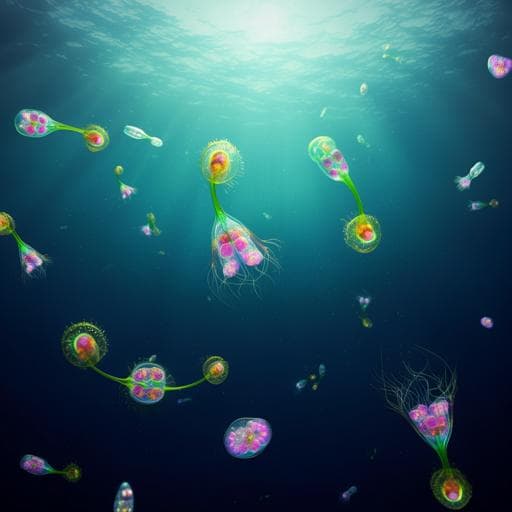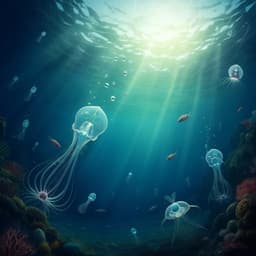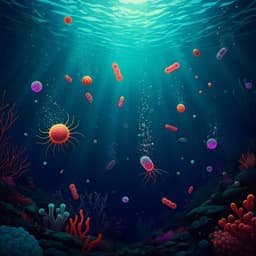
Earth Sciences
Tracing the path of carbon export in the ocean though DNA sequencing of individual sinking particles
C. A. Durkin, I. Cetinić, et al.
This groundbreaking study by Colleen A. Durkin, Ivona Cetinić, Margaret Estapa, Zrinka Ljubešić, Maja Mucko, Aimee Neeley, and Melissa Omand explores how surface phytoplankton communities influence carbon export to the deep ocean. Through 18S rRNA gene sequencing, the researchers unveil the complex interactions between phytoplankton taxa and sinking particles, proposing a novel approach to enhance our understanding of the ocean's biological carbon pump and the carbon cycle.
~3 min • Beginner • English
Introduction
Phytoplankton in the surface ocean account for roughly half of global primary production. A fraction of this production is exported to depth via the biological carbon pump, sequestering carbon from the atmosphere on timescales of centuries to millennia. The strength and efficiency of this pump remain poorly constrained due to limited mechanistic understanding of which surface taxa are exported and under what ecological conditions. Emerging observational tools (satellite ocean color, in situ imaging, high-throughput DNA sequencing) now resolve plankton communities at high taxonomic resolution, but there is no established framework to integrate these biodiversity measures into carbon export models. Prior molecular studies of sediment trap materials corroborate microscopy findings and highlight roles of pico- and nanophytoplankton and heterotrophs in export, yet taxa have not been quantitatively linked to specific export mechanisms. This study combines quantitative, image-resolved particle flux measurements with DNA sequencing of individually isolated sinking particles to identify which surface phytoplankton taxa are exported, how they are packaged by particle size/type, and how degradation shapes detectable communities, thereby enabling incorporation of genetic diversity into mechanistic models of the biological carbon pump.
Literature Review
Previous microscopy and molecular studies have examined the composition of sinking particles, showing important contributions from pico- and nanophytoplankton and heterotrophic protists, and documenting episodic flux events. DNA-based approaches are sensitive to fragmented or hard-to-identify organisms and generally corroborate microscopy. However, existing work has not quantitatively linked specific taxa to distinct export pathways or particle types, hindering integration into models. Studies in the California Current and other regions have highlighted roles for diatoms and Rhizaria in export and emphasized that preserved versus unpreserved trap treatments, as well as particle degradation, can alter detected community composition. The need persists for standardized processing, mechanistic frameworks linking taxa to particle properties (size, sinking speed, remineralization), and scalable observations to inform global models.
Methodology
Sampling occurred during R/V Falkor cruise FK170124 (24 Jan–20 Feb 2017) from Honolulu, HI to Portland, OR, with sediment traps deployed at three stations: two oligotrophic sites (Stations 1 and 2) and one in the California Current (Station 3). Traps were deployed at 150 m for 1–3 days; platforms included a neutrally buoyant sediment trap (NBST) and a surface-tethered Wirewalker (WW) carrying a KC Denmark trap frame. At Station 3, the WW trap was deployed twice (1.67 and 1.04 days). Traps were set 20 m below the mixed-layer depth at Stations 1 and 2, and 110 m below at Station 3, implying differing degrees of in situ degradation prior to collection.
Sediment trap sampling: Each trap carried four collection tubes. One tube on both NBST (12.7 cm diameter, 70 cm height) and WW (7 cm diameter, 45 cm height, no baffle) contained 0.2 µm filtered seawater over a polyacrylamide gel layer for in situ particle imaging and isolation of individual particles. Two WW tubes contained 0.2 µm filtered seawater (salinity 45) over either unpreserved brine (500 mL, salinity 70) or an RNAlater-like preservative for bulk collections. At Station 1, WW tubes were destroyed, so individual particles were isolated from the NBST gel and no bulk DNA samples were available. After recovery, tubes settled for 1 h; overlying water was siphoned; gel jars were removed and imaged via stereomicroscopy. Individual particles >300 µm were pipetted from gels into cryovials and flash-frozen. Four particle classes were isolated: aggregates (semi-translucent, fluffy edges), dense detritus (non-translucent, often fecal pellet fragments), long cylindrical fecal pellets (crustacean-type), and large loose fecal pellets (likely degraded pellets or from non-crustacean zooplankton such as pyrosomes/pteropods). To assess degradation effects from handling, additional particles were isolated from Station 3 gel layers after incubation at 4 °C for 24–48 h post-recovery. Bulk trap materials (unpreserved brine or RNAlater tubes) were filtered onto 0.2 µm polycarbonate filters, flash-frozen, and included any zooplankton swimmers present.
Surface seawater sampling: Mixed-layer seawater was collected by CTD/Niskin at three depths (near-surface, chlorophyll maximum, and base of mixed layer). Pigments were quantified by HPLC (CHEMTAX for functional group biomass proxies). DNA was extracted for 18S rRNA gene amplicon sequencing.
DNA extraction and amplification: DNA from 83 individually isolated particles was extracted using Chelex 100 resin lysis, heat/vortex cycles, and cleanup with Zymo Genomic DNA Clean & Concentrator-10 (final elution 50 µL). DNA from bulk trap filters (n=6) used Qiagen PowerViral DNA/RNA kit. DNA from seawater (n=40) followed phenol:chloroform:isoamyl alcohol extraction. Approximately 420 bp of the 18S rRNA V4 region was PCR-amplified (Forward 5'-CCAGCASCYGCGGTAATTCC-3'; Reverse 5'-ACTTTCGTTCTTGATYRATGA-3'). A total of 81 barcoded PCR amplicons (individual particles + bulk trap samples) were pooled and sequenced (Illumina MiSeq v2, 2×250 bp) at MSU Genomics Core. Seawater amplicons were prepared and sequenced by MR DNA (MiSeq 2×300 bp). Sequences are available under NCBI PRJNA494700.
Bioinformatics and analyses: Reads were processed in QIIME2 with DADA2 to infer amplicon sequence variants (ASVs). Taxonomy was assigned against PR2 database v4.12.0 using a naive Bayes classifier. ASVs were categorized as photosynthetic vs heterotrophic; all non-Syndiniales dinoflagellates were considered phytoplankton; Bacillariophyta were analyzed separately from other Ochrophyta. Analyses included: (1) identifying the fraction of surface phytoplankton ASVs detected in sinking particles (individually isolated or bulk) at Stations 2 and 3; (2) assessing packaging size by identifying ASVs common to bulk traps and individual particles vs those only in bulk (assumed in smaller particles, <300 µm), performed at Station 3; (3) comparing 18S communities among sample types and particle classes using rarified read counts (rarefied to 31,993 reads per sample), Bray-Curtis dissimilarities, MDS ordination, PERMANOVA with Bonferroni adjustment; (4) assessing ASV richness using presence/absence of ASVs detected ≥10 times; (5) evaluating degradation impacts via delayed isolation (24–48 h) and preservative vs unpreserved bulk treatments. Robustness against trap stochasticity was tested by separate analyses of the two Station 3 WW deployments.
Key Findings
- Fraction of surface phytoplankton diversity exported: Similar proportions of distinct surface phytoplankton ASVs appeared in sinking particles at Station 2 (oligotrophic) and Station 3 (California Current): 24% and 26%, respectively.
- Relative read abundance of exported ASVs in surface waters varied by ecosystem and functional group: At Station 2, exported ASVs constituted large proportions of surface ochrophyte reads (89%) and hacrobia reads (49%), but only 10% of diatom reads. At Station 3, exported diatom ASVs represented 78% of diatom surface reads, while exported ochrophyte and hacrobia ASVs were reduced (58% and 15%). Exported dinoflagellate and chlorophyte ASVs were consistently high across ecosystems (dinoflagellates: 67% at Station 2, 78% at Station 3; chlorophytes: 83% and 92%). Variability between two Station 3 trap deployments was <9%.
- Size partitioning of exported diversity (Station 3): 49% of both phytoplankton and heterotrophic ASVs detected in traps were present in large individually isolated particles (>300 µm), implying the remaining 51% were in smaller particles (<300 µm) or not isolated. Chlorophyta had a higher fraction in large particles (64% of exported ASVs), whereas Hacrobia and Opisthokonta were seldom in large particles (23% and 10%).
- Diatom size-specific packaging: ASVs found only in the small-particle fraction corresponded to very large diatom genera (Rhizosolenia, Proboscia, Coscinodiscus) and chain-forming Bacteriastrum; large particles contained small/lightly silicified diatoms (e.g., Minidiscus ~4 µm, Cylindrotheca, Guinardia), indicating that small cells were exported via incorporation into large fecal pellets/aggregates, while large diatoms sank individually or within small aggregates.
- Community composition patterns: Across all sample types and locations, heterotrophs dominated reads (80±16%). Seawater size fractions showed expected shifts (e.g., Pelagomonadales in oligotrophic waters; Mamiellales in California Current). Particle communities differed between oligotrophic and coastal sites and among particle classes at Station 3. Aggregates differed significantly from large loose pellets and dense detritus (PERMANOVA p<0.001). Large loose pellets were enriched in Group-II Clade-10/11 Syndiniales, Chloropicon, Prasinoderma, and Minidiscus relative to aggregates; aggregates had more Group-I Clade-I Syndiniales.
- Diversity and degradation: Phytoplankton ASV richness was higher in large loose pellets and decreased in dense detritus and aggregates; after 1–2 days of 4 °C incubation, phytoplankton richness converged among particle types. Heterotroph ASV richness did not differ among particle types but declined with incubation time. Taxon-specific degradation responses: dinoflagellate ASV richness decreased by up to 82±31% after shipboard incubation; diatoms decreased by 55±40% over 2 days; Chloropicophyceae appeared unaffected. Diversity in bulk trap samples differed between preserved and unpreserved treatments, with direction and magnitude varying by group and deployment.
- Export mechanism quantification framework: By combining imaging-based POC flux modeling with genetic assignments, the study mapped surface phytoplankton biomass (from HPLC) to exported taxa and their packaging into small vs large particles (e.g., Station 3 example in mmol C m⁻² and mmol C m⁻² d⁻¹), informing sinking speeds and attenuation parameters for models.
Discussion
Linking 18S rRNA gene communities from surface waters to individually resolved sinking particles revealed how ecological mechanisms of export vary between oligotrophic and coastal ecosystems and among functional groups. The dominant determinant of a taxon’s export pathway was the size/type of the particle that packaged it, reflecting food-web interactions (e.g., filter-feeding zooplankton producing large loose fecal pellets that export small phytoplankton). The contrasting patterns for diatoms between the subtropical gyre and California Current align with known regional roles in carbon cycling. The detection of large diatoms exclusively in the small-particle fraction supports their ability to sink as individual cells or small aggregates, while small diatoms detected only in large particles indicate reliance on zooplankton packaging for effective export. Heterotroph dominance in reads and particle-type differences in community composition suggest complex colonization and transformation during sinking. Degradation significantly alters detectable diversity in a taxon-specific manner, serving both as a marker of remineralization and a source of bias in interpreting export contributors. By scaling relative read abundances within functional groups to HPLC-derived biomass and associating taxa with particle size classes and types, the study provides a pathway to parameterize mechanistic biological pump models with taxon-specific export mechanisms, sinking speeds, and remineralization behaviors. Seasonal and regional variability (e.g., differences from prior Rhizaria findings) underscores the need for broader, time-resolved observations to generalize linkages.
Conclusion
This work establishes a framework that connects surface phytoplankton community composition to specific export mechanisms by sequencing DNA from individually isolated sinking particles and bulk trap collections, integrated with particle imaging and flux modeling. It quantitatively identifies which surface taxa are exported, the particle sizes/types that package them, and how degradation shapes detectable diversity. The approach enables incorporation of genetic diversity into mechanistic models of the biological carbon pump by linking taxa to particle properties that control sinking and remineralization. Future research should constrain degradation-driven biases and standardize preservation/processing, expand spatial and seasonal coverage to identify generalizable relationships, and leverage optical signatures from forthcoming satellites to infer surface community-export linkages at synoptic scales.
Limitations
- Degradation bias: Particles continued to degrade during trap deployment and post-recovery handling; taxon-specific loss of detectable DNA (e.g., strong for dinoflagellates) can underrepresent contributors to export.
- Preservation effects: Differences between preserved and unpreserved bulk samples affected diversity estimates inconsistently across taxa and deployments.
- Sampling constraints: At Station 1, bulk trap DNA samples were unavailable; Station 3 analyses were emphasized due to larger particle counts, potentially limiting generality.
- Swimmer contamination: Bulk trap samples included actively entering zooplankton, complicating attribution of heterotroph origin (surface export vs mesopelagic colonization).
- Molecular biases: Relative read abundance as a proxy for biomass is taxon-dependent (e.g., variable rRNA gene copy numbers); classification choices (e.g., treating most dinoflagellates as phytoplankton) may include mixotrophs/heterotrophs.
- Integration scale mismatch: Surface water and trap samples integrate different time and space scales, potentially obscuring direct linkages.
- Seasonal/regional variability: Findings may vary seasonally and regionally (e.g., differing Rhizaria contributions reported elsewhere), requiring broader datasets for generalization.
Related Publications
Explore these studies to deepen your understanding of the subject.







